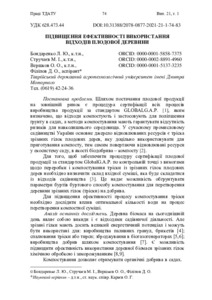Please use this identifier to cite or link to this item:
http://elar.tsatu.edu.ua/handle/123456789/14162Full metadata record
| DC Field | Value | Language |
|---|---|---|
| dc.contributor.author | Бондаренко, Лариса Юріївна | - |
| dc.contributor.author | Бондаренко, Лариса Юрьевна | - |
| dc.contributor.author | Bondarenko, Larysa | - |
| dc.contributor.author | Стручаєв, Микола Іванович | - |
| dc.contributor.author | Стручаев, Николай Иванович | - |
| dc.contributor.author | Struchaiev, Mykola | - |
| dc.contributor.author | Вершков, Олександр Олександрович | - |
| dc.contributor.author | Вершков, Александр Александрович | - |
| dc.contributor.author | Vershkov, Oleksandr | - |
| dc.contributor.author | Філіпов, Д. О. | - |
| dc.date.accessioned | 2021-05-31T08:55:04Z | - |
| dc.date.available | 2021-05-31T08:55:04Z | - |
| dc.date.issued | 2021 | - |
| dc.identifier.uri | http://elar.tsatu.edu.ua/handle/123456789/14162 | - |
| dc.description.abstract | UK : Робота присвячена дослідженню процесу компостування тріски зрізаних гілок плодових дерев. Наведено методику визначення необхідної кількості води для забезпечення якісного протікання термічних перетворень у процесі компостування. Запропоновано використання зворотної системи зволоження по замкнутому циклу, яка дозволить підвищити ефективність процесу компостування за рахунок рівномірного зволоження компосту з відповідним дозуванням витрати води. Запропонована методика розрахунку визначення оптимальної кількості води для зволоження компосту може бути використана при проектуванні компостування і підбору обладнання. RU : Работа посвящена исследованию процесса компостирования щепы срезанных ветвей плодовых деревьев. Приведена методика определения необходимого количества воды для обеспечения качественного протекания термических преобразований в процессе компостирования. Предложено использование оборотной системы увлажнения по замкнутому циклу, которая позволит повысить эффективность процесса компостирования за счет равномерного увлажнения компоста с соответствующим дозированием расхода воды. Предложенная методика расчета определения оптимального количества воды для увлажнения компоста может быть использована при проектировании компостирования и подбора оборудования. EN : The article is devoted to improving the efficiency and stability of compost production by determining the optimal amount of water and additives introduced during the composting process using a circulating humidification system. In order to provide the procedure for certification of fruit products according to the GlobalG.A.P. it is necessary to determine the composition of the initial mixture from horticultural waste. This makes it possible to substantiate the parameters of the pile method. To achieve this goal, it is necessary: to propose a calculation method and a paradigm for determining the optimal amount of water for moistening compost; to propose a scheme for a recycling compost humidification system. After analyzing the raw materials, they proceed to the initial stage at which the mixture for composting is prepared, mixed and moistened to the required moisture content. To ensure uniform compost moisture and appropriate dosage of water and additives, it is proposed to use a circulating humidification system. Humidification during composting is carried out in a closed cycle. Water from the storage tank is pumped through a filter and dispenser into a spray comb installed above the compost pile. Excess water flows back into the storage tank. At the first stage, the raw materials are soaked and brought to the required moisture content of 70–80%, and at the second, the compost is moistened when it is poured. Part of the water is absorbed by the compost mass, the excess, which contains useful substances, is drained back into the storage tank. Fermentation of both insufficiently moist and waterlogged compost is less effective, and when "filling" its process may stop altogether. Therefore, it is important to correctly calculate the amount of water for humidification. The proposed method for calculating the determination of the optimal amount of water for moistening the compost and the scheme of the circulating system for moistening the compost can be used in the design of composting and selection of equipment. | uk |
| dc.language.iso | uk | uk |
| dc.publisher | ТДАТУ | uk |
| dc.relation.ispartofseries | Праці Таврійського державного агротехнологічного університету : наукове фахове видання;Вип. 21, т. 1 (С. 74-83) | - |
| dc.subject | компост | uk |
| dc.subject | підвищення ефективності | uk |
| dc.subject | тріска | uk |
| dc.subject | оборотна система зволоження | uk |
| dc.subject | листя | uk |
| dc.subject | курячий послід | uk |
| dc.subject | компост | uk |
| dc.subject | повышение эффективности | uk |
| dc.subject | щепа | uk |
| dc.subject | оборотная система увлажнения | uk |
| dc.subject | листья | uk |
| dc.subject | куриный помет | uk |
| dc.subject | compost | uk |
| dc.subject | efficiency | uk |
| dc.subject | splinters | uk |
| dc.subject | circulating system moisture | uk |
| dc.subject | leaves | uk |
| dc.subject | chicken droppings | uk |
| dc.title | Підвищення ефективності використання відходів плодової деревини | uk |
| dc.title.alternative | Повышение эффективности использования отходов плодовой древесины | uk |
| dc.title.alternative | Improving the efficiency of use waste fruit wood | uk |
| dc.type | Article | uk |
| Appears in Collections: | Кафедра Інженерної механіки та комп'ютерного проектування | |
Files in This Item:
| File | Description | Size | Format | |
|---|---|---|---|---|
| Підвищення ефективності використання відходів плодової деревини(74-83).pdf | 699.05 kB | Adobe PDF |  View/Open |
Show simple item record
CORE Recommender
???jsp.display-item.check???
Items in DSpace are protected by copyright, with all rights reserved, unless otherwise indicated.
